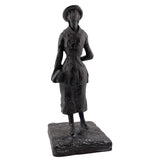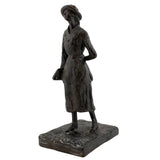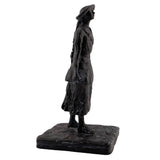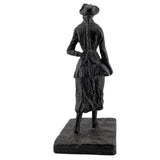French Young School Girl Walking 19th Century Clothes Statue by Degas 7H attic as is, no returns
PN# DE07-as-is**ONLY 1 LEFT / MANUFACTURER RETIRED / NO DAMAGE, BUT NO ORIGINAL BOX, the item pictured is the exact one your will receive**
School Girl Walking Sculpture By Edgar Degas (c. 1881)
This statue reproduces an original by Edgar Degas. Here a young school girl wearing a skirt carries her school books. Degas is most famous for his Little Ballerina statue but he also made a number of studies of a female in motion.
- Museum reproduction of Degas' School Girl Statue is part of the highly collectible Parastone Mouseion 3D Collection. PN DE07.
- Made from resin with a bronze finish and measures 7 in H x 3.5 in L x 2.75 in W. Weight 0.65 lbs.
Degas' idiosyncratic sculptures exist outside the 19th-century French sculptural tradition because of their interest in realism, an unidealized rendering of every day life. With the exception of the, now famous, Little Dancer of Fourteen Years, Degas never exhibited any of his sculptures. After his death, over 150 wax sculptures were found at his studio. Some were rough studies, but many were very refined.
Perhaps it was due to his visual handicap that, later in life, wax modeling appealed to Degas so strongly. His motto was: "Le dessin n'est pas la forme, c'est la maniere de la voir" (the design is not the form, but the method of viewing). This definitely applies to The School Girl with her half shy, half saucy walk.
The course of life of the Parisian painter had few dramatic peaks. Being the eldest son of a well-to-do family, the cynical, snobby loner was able to devote his life to the arts. Furthermore, he remained a bachelor, because: There is love and there is work, and we only have one heart.
His classical education can be recognized in his earlier work, in particular the strict composition and lining inspired by Ingres whom he greatly admired. Degas took a special position within the group of artists led by his friend Monet, who regularly got together in the Cafe Guerbois. His cynicism and sharp tongue however, made him difficult in company and many ideas from Zola, Renoir and Monet did not appeal to him. Although he referred to himself as an 'independent realist', he was very much involved in the impressionistic revolution and the themes and techniques developed the traditional and modern art of painting. In 1874, together with Monet, he organized the first exhibition of the independents, which was named the impressionists by a critic.













